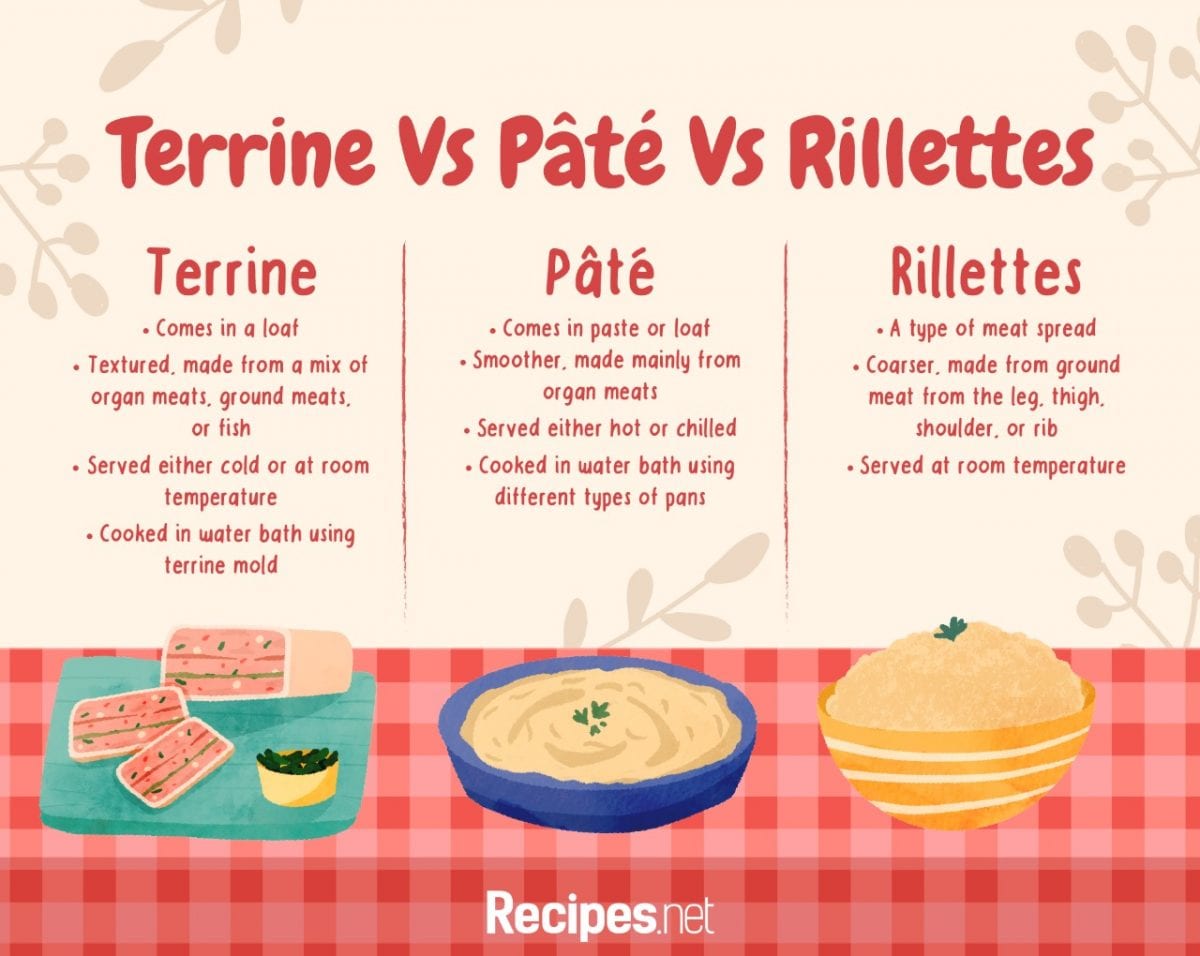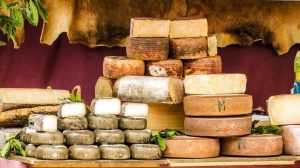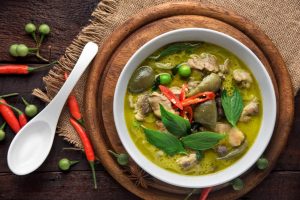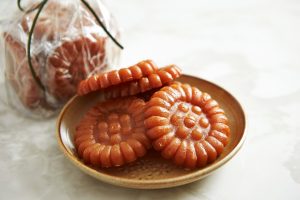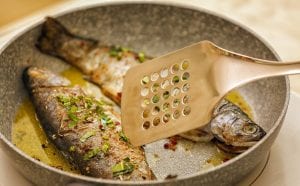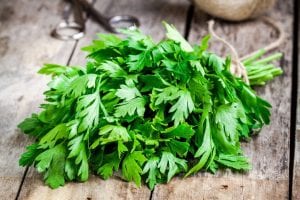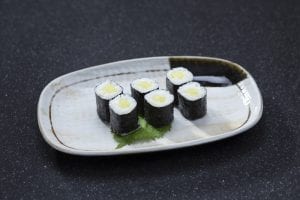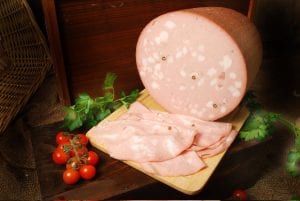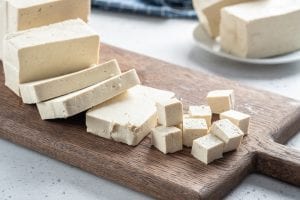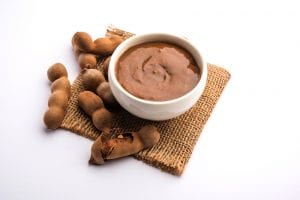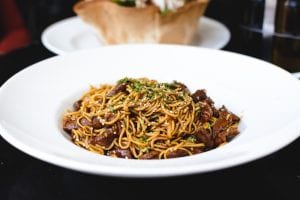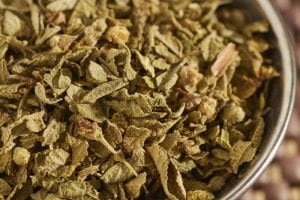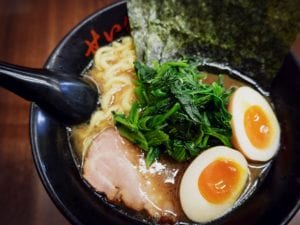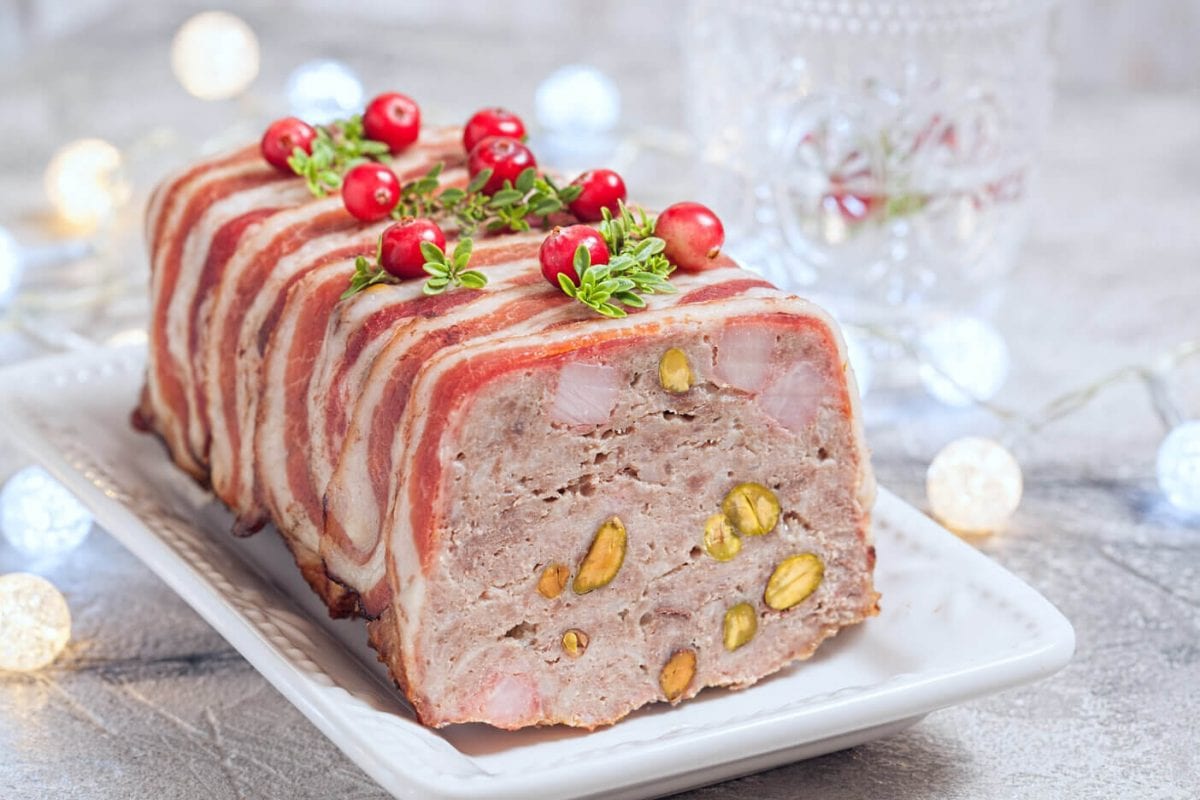
Considering all the different meat products that can be found on a charcuterie board, it is no surprise that many are confused between a pâté and a terrine, two staples of the charcuterie. Although both are made from forcemeat, these are in fact two very different dishes.
Continue reading to learn everything there is to know about terrine, how it differs from pâtés and rillettes, and the different ways you can prepare and serve it.
What Is Terrine?
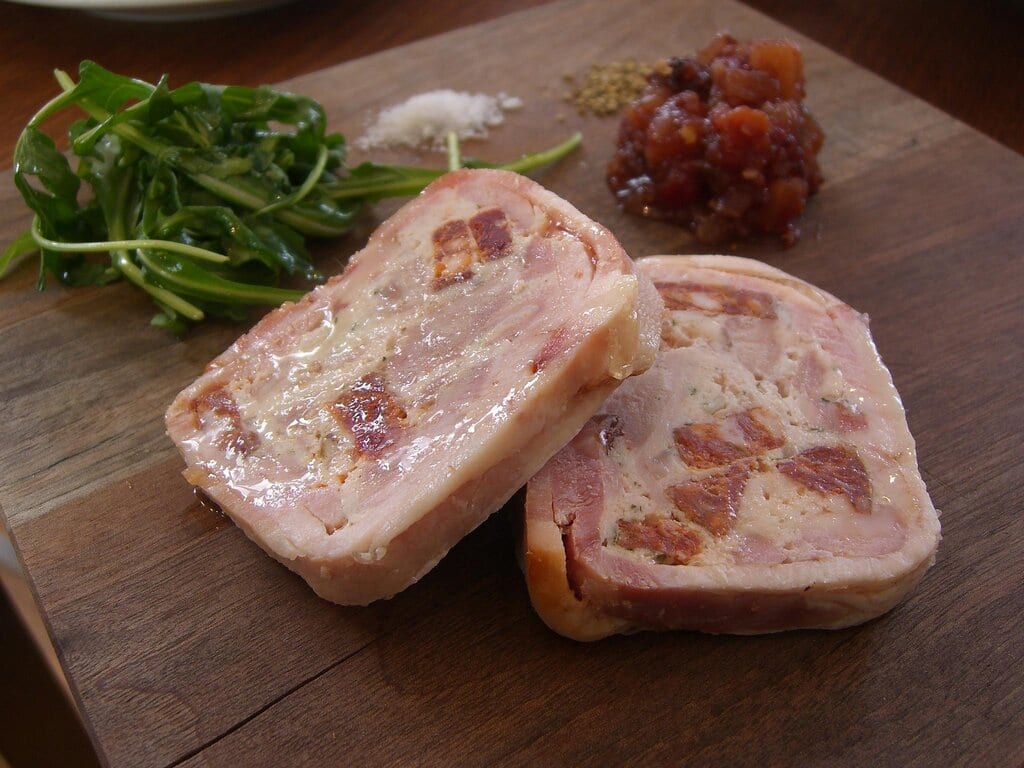
The term “terrine” is a french word meaning “large earthenware pot”. That’s because in the past, terrine literally meant the container that the dish was made in.
Today, “terrine” has two definitions. We have inherited the use of “terrine” to refer to the deep rectangular or oval cookware used to make the dish. The term has also come to refer to the dish itself. It is a dish of layered ground meats, organ meats, vegetables, and seasonings, packed tightly into the shape of a loaf and cooked in a water bath. Sometimes, you can also coat a layer of gelatin, commonly known as aspic, on top. The aspic holds the dish together and adds an extra layer of flavor to it.
For another exquisite dish that is also cooked in a water bath, take a look at our article on Mortadella and 3 Recipes to Try.
Difference Between Terrine, Pâté, and Rillettes
There has been a great deal of confusion over what exactly constitutes a terrine, a pâté, and a rillette. Although all three fall under the umbrella of forcemeat dishes, there are still many differences that make each dish distinct.
Pâté
Pâté is a paste or loaf filled with forcemeat, which can be made of a variety of meats, though they mainly feature organ meats such as duck or chicken livers. There are two types of pâté. The French bake their pâtés in a crust or mold and serve it in thin slices. In Eastern European cuisine, however, pâtés are cooked down into a more spreadable texture. People often pair this type of pâté with sliced bread or crackers.
One source of the confusion between pâtés and terrines comes from the fact that pâtés can be used as one of the layers in a terrine. Make no mistake, however: pâtés might be an ingredient in making terrines, but they are not the same dish. Another difference is that terrines are specifically cooked in a terrine mold. Pâtés, on the other hand, can be cooked in pans of different shapes.
The two dishes also differ in their serving temperatures. Pâtés become more flavorful after several days of chilling, but can also be served either hot or cold. This is in contrast to terrines, which you serve either cold or at room temperature. Finally, pâtés are smoother and lighter than terrines, which combine smooth organ meats, coarser ground meats and even fish and seafood to produce a much more textured dish.
Rillettes
Yet another delicacy of French cuisine, rillettes are a type of shredded meat spread, made from fish or poultry. Rillettes are slowly cooked in a mix of fat and herb seasonings to produce a smooth, intensely rich flavor. Although pork rillettes are the most common type of rillette, this dish can also be made with other meats such as turkey rillette, duck rillette, or even salmon rillette, all to your liking.
Unlike terrines and pâtés, rillettes are made with a different method of preservation, which is also known as “rillettes”. In addition, rillettes also tend to use different types of meat. Pâtés, which have a smoother taste, often use organ meats that are finer in texture such as tripe or liver. Rillettes, however, are typically made with chunkier meat from the leg, thigh, shoulder, or rib.
One final difference between rillettes and terrines is in the way each dish is served. Since rillettes are spread on and eaten with slices of bread, they do not constitute a meal by themselves. This is unlike terrines, which are loaves of forcemeat that can be eaten as full courses.
Popular Ingredients For Terrine
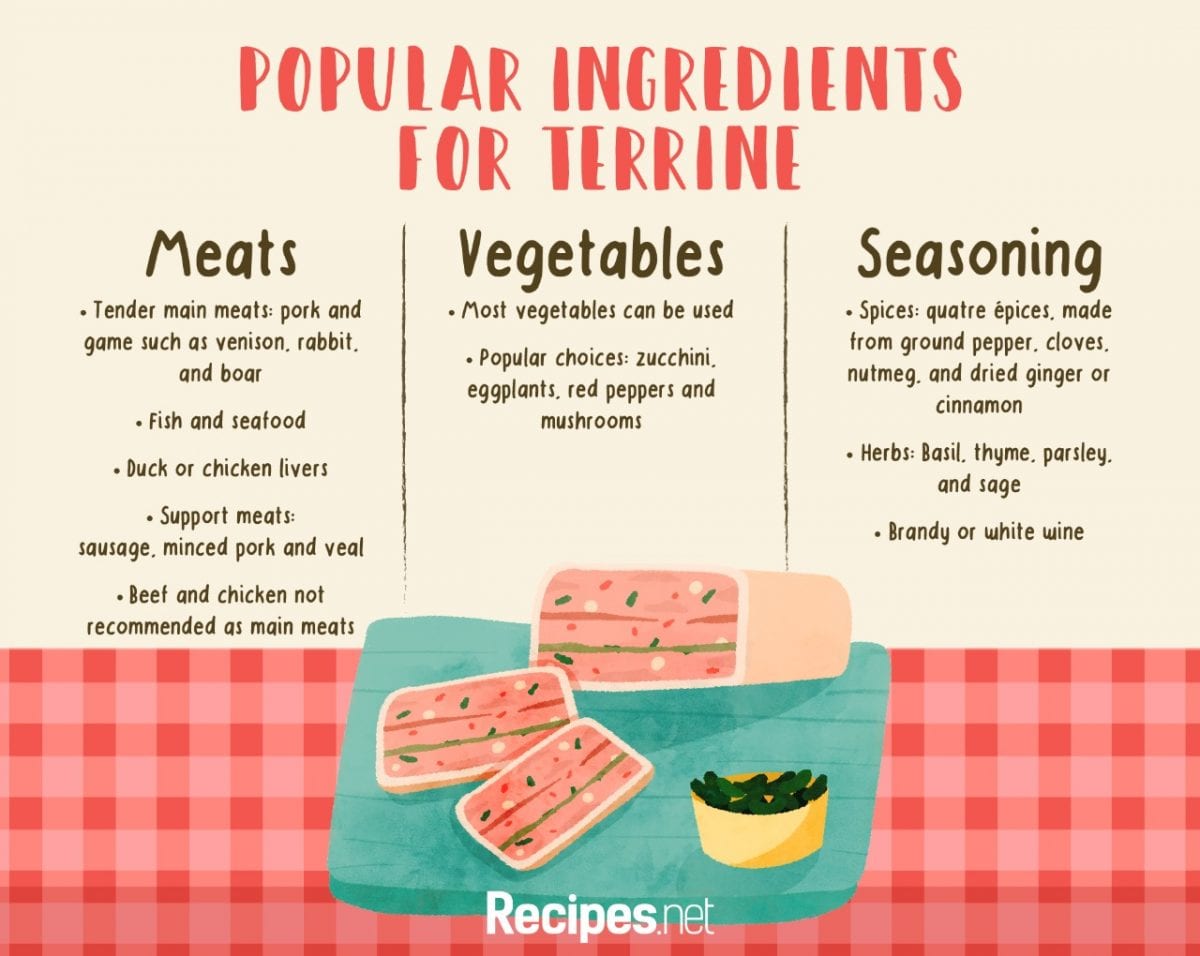
Meats
The most popular main meats used are pork or game such as venison, rabbits, boar, and more. These meats are sufficiently tender and cook quickly, becoming more flavourful once cooked. Beef is less preferable, as it is too dense and takes much longer to cook than the other meats. Likewise, chicken is not an ideal choice, as it is not flavourful enough and requires too much heavy seasoning. An especially popular type of terrine is terrine de campagne, also known as country terrine, made from pork and liver. This is a popular combination as the smoothness of liver meat tends to pair especially well with coarser pork meat. You can also make terrines with fish and seafood as the main meats – smoked salmon terrine, for instance, is a wonderful starter for Christmas day dinners.
For support meats, sausage meat, minced pork, and veal are excellent choices to pad out the dish with.
Vegetables
Almost any kind of vegetable goes well with terrines, which makes it a convenient dish for those who home-grow their own vegetables. Some popular choices include zucchini, eggplants, red peppers, and mushrooms.
It is also possible to make vegetarian terrines. However, layering such a dish can be a delicate task. You’ll have to carefully mix vegetables that have stronger flavors with more delicately flavored vegetables, to prevent it from being too bland. Unlike meat-based terrines though, vegetarian terrines are usually served as appetizers to a meal.
Check out some other delicious vegetarian meals with these 30 Vegetarian Instant Pot Recipes.
Seasoning
Herbs, spices, and even alcohol are all ingredients that you can use to season a terrine. The most popular spice used is quatre épices. This is a French spice mix most commonly made from ground pepper, cloves, nutmeg, and dried ginger, although cinnamon is often used as a substitute for ginger. Fresh herbs like basil, thyme, parsley, and sage are especially popular in country terrines. Finally, some brandy or white wine adds an additional splash of flavor to the terrine.
Tips for Making Terrine
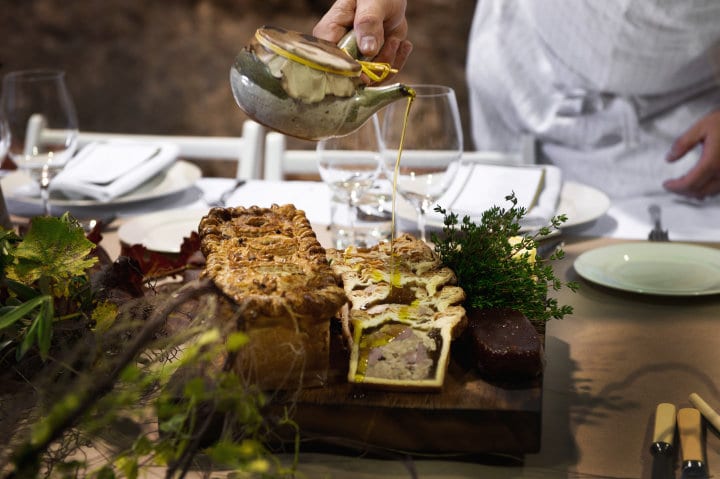
Type of Terrine Mold
Although people predominantly made terrines with pottery molds in the past, terrine molds today can be made from all kinds of materials. These include cast iron, ceramic glass, stainless steel, porcelain, and many more. When faced with so many choices, how do you decide which is the best type of mold to use?
We recommend using molds made out of enameled cast-iron, which can cook through the layers of terrine more evenly. In particular, you want to avoid molds made of pure aluminum and uncoated iron. These materials can leave an unpleasant taste in terrines that make use of acidic ingredients like tomatoes and dairy products.
How to Slice Terrine
Terrine is often served in thick slices. As a result, sometimes it can crumble while you’re making the cut. To prevent this, wrap it tightly in cling film before slicing it. By doing so, you ensure that it still looks great when being plated.
Pre-Roasting the Vegetables
If you are making a vegetable terrine, don’t forget to roast or char-grill the vegetables first. This will give your terrine dish a strong smokey flavor.
How to Serve and Eat Terrine
Once a terrine has cooled, it is most often served in thick slices on a charcuterie board, along with a wide variety of cured meats, sausages, cheeses, and bread. Popular choices for cheese include blue cheese or goat cheese. Crusty breads also go especially well with terrines, so sourdough bread, rye bread, or baguettes are excellent choices.
For those looking for something lighter, perhaps as a starter, you can also eat a simple meal of vegetarian or foie gras terrine, paired with hot toast, butter, and pickled vegetables such as gherkins or caper berries.
A Dish for the Imaginative Chef
The great thing about terrines is that you can make them from almost any combination of ingredients, from common meats like pork and sausage meats to gourmet cuisine like foie gras and venison. This makes it an excellent dish for adventurous chefs. When it comes to creating inventive, richly-flavored terrine recipes, the sky is the limit.
